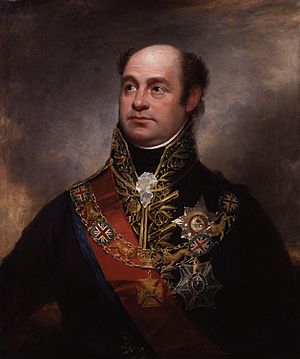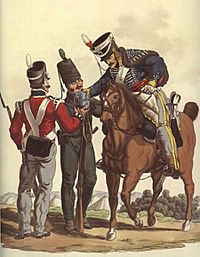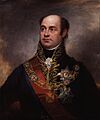Robert Ballard Long facts for kids
Quick facts for kids
Robert Ballard Long
|
|
|---|---|

Lieutenant-General Robert Ballard Long. Mezzotint, 1827.
|
|
| Born | 4 April 1771 Chichester, West Sussex |
| Died | 2 March 1825 Berkeley Square, London |
| Allegiance | |
| Service/ |
|
| Years of service | 1791 to 1821 |
| Rank | Lieutenant General |
| Battles/wars | French Revolutionary Wars • Flanders Campaign • Irish Rebellion of 1798 Napoleonic Wars • Battle of Corunna • Walcheren Expedition • Campo Mayor • Albuera Campaign • Arroyo dos Molinos • Battle of Vitoria • Battle of Pyrenees • Siege of Pamplona |
Lieutenant-General Robert Ballard Long (born April 4, 1771 – died March 2, 1825) was a brave officer in the British and Hanoverian Armies. He served in many important wars, including the French Revolutionary Wars and the Napoleonic Wars. Even though he fought in many battles, he never reached the very highest command positions. This was partly because he sometimes had disagreements with his superiors.
Long was a cavalry commander during the Peninsular War from 1811 to 1813. The main British commander, Wellington, had some concerns about Long's abilities. Other senior officers, like Sir William Beresford, also expressed their thoughts. After Long's death, there were debates about his military record. However, more recent studies have looked at his performance as a cavalry general more positively.
Contents
Early Life and Joining the Army
Robert Ballard Long was born in Chichester in 1771. He was one of twin sons. His father, Edward Long, was a planter from Jamaica.
Robert went to school at Dr Thomson's School in Kensington until he was nine. Then he attended Harrow School until he was 18. After school, he spent three years studying military ideas at the University of Göttingen in Germany.
In 1791, Long joined the 1st King's Dragoon Guards as a cornet. This was a junior officer rank. His family had a lot of money, which helped him get promoted quickly. By November 1793, he was a captain.
First Campaigns
Long served with his regiment in Flanders during a campaign led by the Duke of York. This campaign was not successful. In the winter of 1794 and 1795, Long worked with General Sir George Don during the army's retreat.
After returning to England, Long became an aide-de-camp to General Sir William Pitt. Pitt was in charge of the defenses at Portsmouth. Their friendship helped Long later in his career.
In 1796, Long joined the Hanoverian Army. He first served as an officer in the York Rangers. Then he commanded the Hompesch Mounted Riflemen. He bought this command from Baron Hompesch for £2,000. This regiment helped put down the Irish Rebellion of 1798. Long served in the town of Wexford during this time.
After the rebellion, Long served with the York Hussars. This was another Hanoverian cavalry unit. He stayed with them in Weymouth until the Peace of Amiens in 1802.
Training and New Regiments
During the peace, Long studied at the Royal Military College at High Wycombe. He became friends with John Le Marchant, who was a leader there.
When war started again, Long joined the 16th Light Dragoons as a lieutenant colonel. In 1805, he moved to the 15th Light Dragoons. This regiment was under the command of the Duke of Cumberland.
Long quickly had disagreements with Cumberland. They both tried to command the regiment without talking to each other. This led to years of arguments. Long also disagreed with Cumberland's use of harsh punishments. The regiment was later changed into a hussar unit. Its name became the 15th 'King's' Light Dragoons (Hussars).
Long was highly regarded by the soldiers under his command. An anonymous book called "Jottings from my Sabretasch" mentions him often. The author, a sergeant in the 15th Light Dragoons, thought Long was an excellent commander. He believed Long was responsible for many improvements in the regiment.
Service in the Peninsular War
In 1808, Long joined Sir John Moore's army in Spain. When Long arrived, Moore was preparing for the Battle of Corunna. This was a difficult battle at the end of a tough campaign. Long did not have a command during the battle. He served on Moore's staff and was likely present when Moore died.
After returning to England, Long joined Lord Chatham's Walcheren Expedition. This campaign was a failure. It suffered from bad planning, heavy rain, strong French resistance, and a terrible sickness called "ague" (likely malaria). Many soldiers died from this illness.
In 1810, Long returned to active service with Wellington's army in the Peninsula. He took command of the cavalry for Sir William Beresford. This was during the first Allied siege of Badajoz. Long took command of the cavalry on March 21, 1811.
Campo Mayor and Albuera
Just four days after taking command, Long's cavalry saw action at the Campo Mayor on March 25, 1811. This battle became quite controversial. Beresford believed Long had lost control of his light cavalry. They had chased French cavalry for miles, even close to the fortress guns of Badajoz. Some historians later agreed with Beresford, calling the action reckless.
However, the army generally supported the 13th Light Dragoons, who had chased the French. The 13th had charged and routed six enemy squadrons, even though they had fewer soldiers. Historian Sir John Fortescue praised the 13th, saying it was hard to speak too highly of their performance.
Long believed that if Beresford had allowed the British heavy dragoons to join the fight, the entire French column could have been captured. Historian Sir William Napier later supported Long's view. This event marked the beginning of a difficult relationship between Beresford and Long.
At the next clash at Los Santos on April 16, 1811, Long kept his heavy dragoons under his command. They defeated the French cavalry, causing significant losses to the French 2nd Hussars.
Long was later ordered to retreat from action twice without fighting. He believed he was only told to fall back to a certain position, not to delay the French. He withdrew too quickly, which frustrated Beresford. Beresford then replaced Long with a more senior general, William Lumley, on the day of the Battle of Albuera. Long still fought bravely in the battle, but under Lumley's command. Long also served under Lumley at the Battle of Usagre on May 25, 1811. There, the British cavalry cleverly trapped two French dragoon regiments at a bridge, causing many casualties.
Later Campaigns
In June 1811, Long was promoted to major general. He was given command of a light cavalry brigade. These troops were involved in a skirmish near Elvas. About fifty men of the 11th Light Dragoons were captured. Wellington was present and gave Long a strong reprimand. This slowed down Long's career. However, Long's political friends were powerful enough to keep him in active service.
Long commanded the cavalry under Sir Rowland Hill at the Battle of Arroyo dos Molinos. In this battle, an entire French infantry division and several cavalry regiments were trapped and destroyed. Long's cavalry charged and broke the French cavalry. They captured over 200 French soldiers and three cannons. The French cavalry commander, General Bron, was also captured.
In 1813, Long commanded a brigade at the Battle of Vitoria. He also fought at the Battle of the Pyrenees later that year. During Marshal Soult's large attack across the Pyrenees, Wellington's forces were spread out. Long's brigade was a crucial link between two main groups of Allied troops.
In this situation, Long performed a very important service. General Lowry Cole sent a message to Wellington. It said that a French army of about 35,000 men had forced him to retreat. This message came into Long's hands. On his own initiative, Long opened it and made a copy. He sent the copy to his immediate superior, Sir Rowland Hill. Hill then sent the message to Wellington. The original message went to Wellington's old headquarters and did not reach him that evening. Long's smart actions allowed Wellington time to react to the French movements. If there had been a delay, the results could have been very bad for the Allied army.
End of Active Service
Long's last action was in the Siege of Pamplona. After this, the Duke of York called him back to England. Wellington agreed to this. Long wrote to Wellington, who assured him that he had not asked for Long's recall. Long suspected that the Prince Regent had arranged his recall. This would allow the Prince's favorite, Colquhoun Grant, to command Long's brigade.
Long refused a new posting as a divisional commander in Scotland. He retired to his estate at Barnes Terrace, Surrey.
Long was promoted to lieutenant general in 1821, even though he was retired. However, he did not receive royal honors like knighthoods or titles. This was likely due to his disagreements with powerful figures, including two royal princes. He died without children in 1825 at his London home. He was buried in his family's crypt at Seale, Surrey.
Legacy and Reputation
After Robert Long's death, his nephew, Charles Long, wrote several pamphlets. These writings defended his uncle's reputation and criticized his opponents. Debates about Robert Long's military career continued for many years.
Robert Long was a dedicated and brave officer. His reputation sometimes suffered because of his personality. While his record as a cavalry general had ups and downs, he helped achieve several victories. These included Los Santos, Usagre, and Arroyo dos Molinos. It is a shame that he is often remembered mostly for the long arguments about the Campo Mayor action.
His soldiers and junior officers liked and respected him. He famously refused to let Wellington's criticism of the 13th Light Dragoons be put into their official record. The soldiers called him "Bobby Long." The officers and men of the 13th Light Dragoons even bought him a set of silver plates as a gift when he was replaced.
However, Long often had conflicts with his superiors. When these superiors included royal princes and a field marshal, it naturally affected his career. For example, after Campo Mayor, Long bothered Beresford by asking for very detailed clarifications of every order. Long did not seem to realize that he could not win these arguments. Beresford was his superior and had more power. Long's actions backfired, and Beresford replaced him as cavalry commander as soon as he could.
Long wrote many letters, especially to his twin brother Charles. These lively letters from the Peninsular War were collected and published in 1951. They offer valuable insights into how Wellington's army worked, especially the cavalry.
Images for kids










